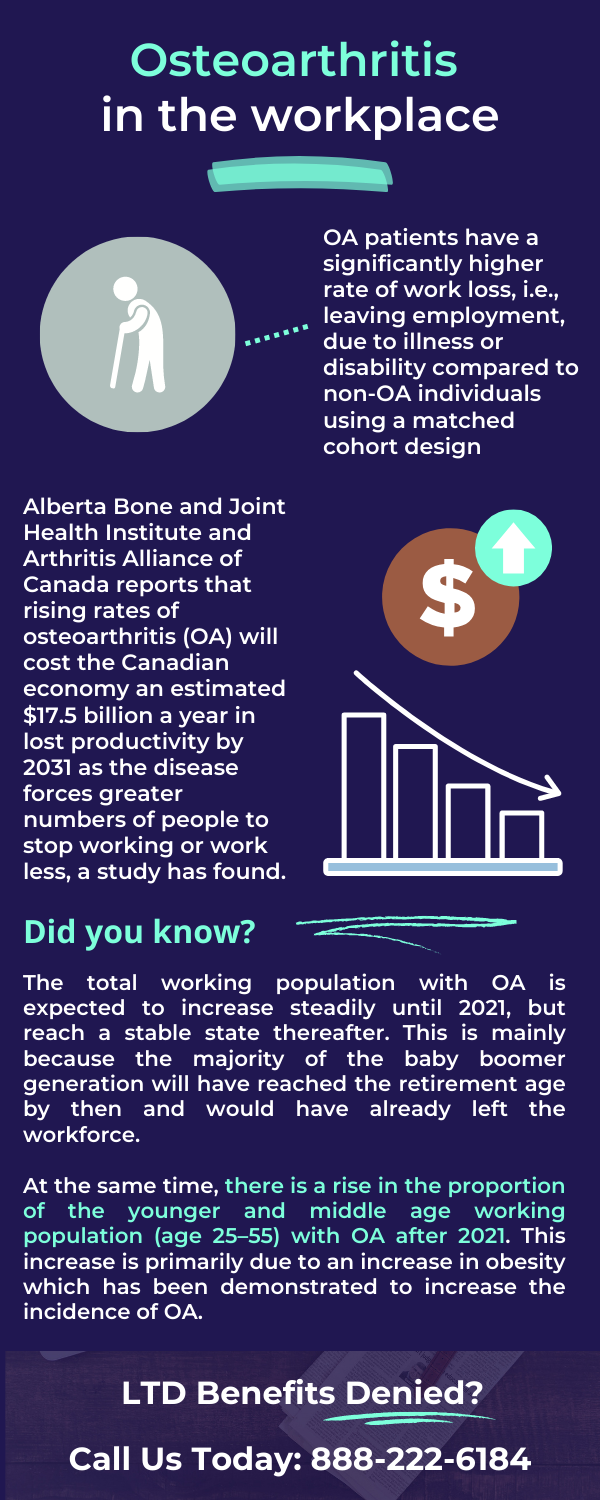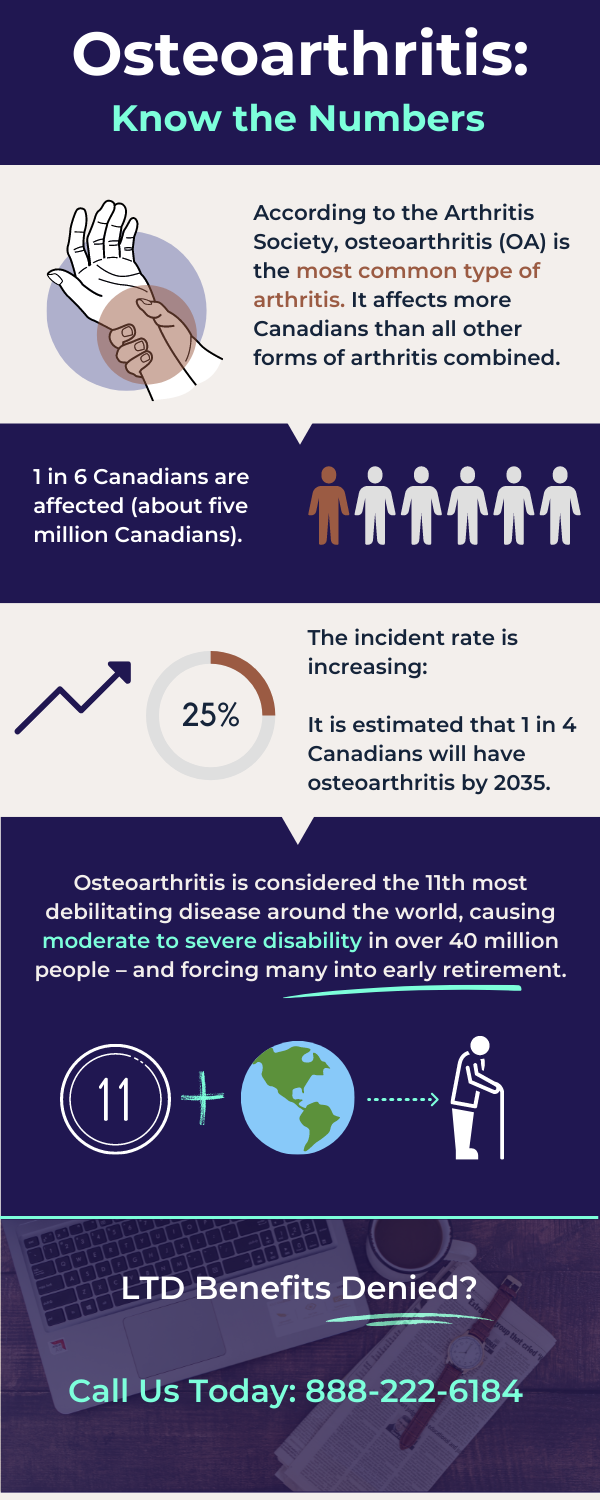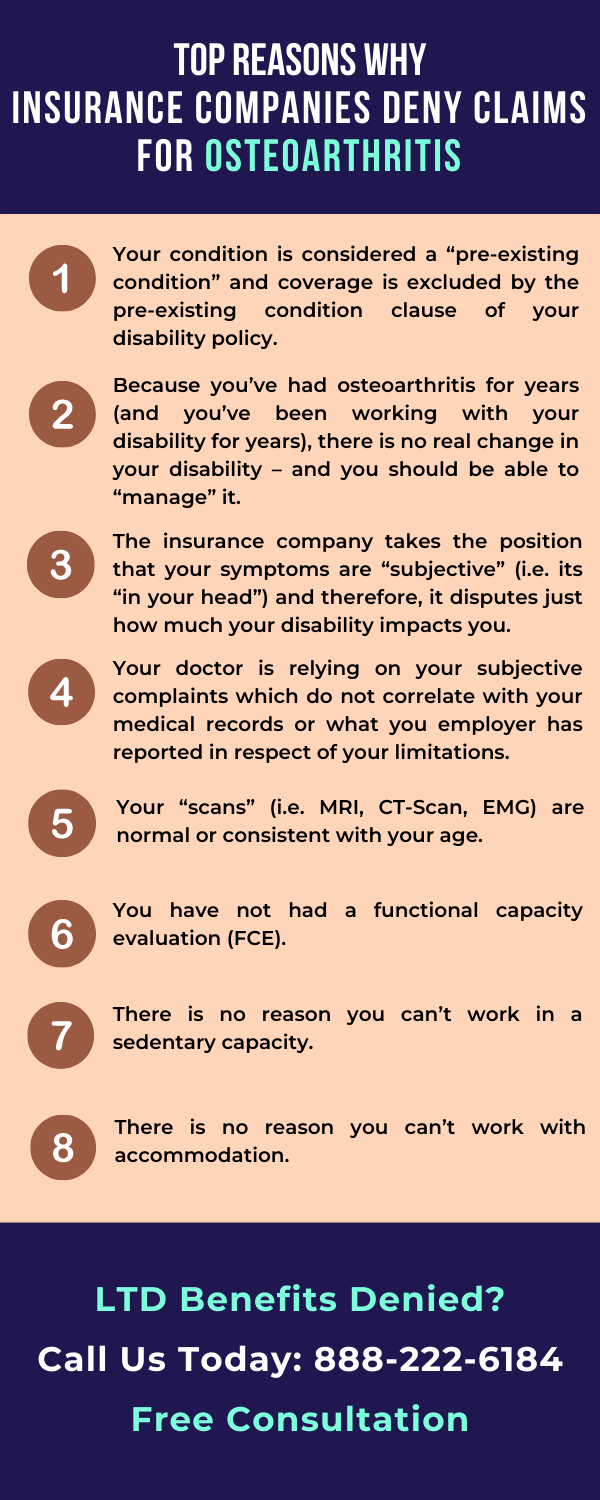Do I qualify for long-term disability benefits if I have Osteoarthritis (OA)?
Osteoarthritis (OA) and Long-Term Disability Benefits
Can you get long-term disability benefits if you have osteoarthritis (OA)?
One of the most common questions we get is “Do I qualify for long-term disability benefits if I have osteoarthritis (OA)?”
Osteoarthritis is a progressive disease of the whole joint that leads to breakdown of joint cartilage and the underlying bone.
Osteoarthritis is a major cause of disability and it can qualify for long-term disability benefits (also called LTD benefits).
Has your claim for disability benefits been denied? Has the insurance company denied your appeal? Were you receiving benefits and the insurance company terminated those benefits?
The experienced team at Ertl Lawyers can help you.
We’ll work with you and your physician to help challenge the insurance company’s denial or discontinuance of your long-term disability benefits.
Where necessary, we will engage other trusted professionals to support your case including specialists, functional capacity evaluators, and vocational evaluators to help credibly explain why your disability symptoms are preventing you from doing your “own occupation” or “any occupation”.
Ertl Lawyers offers:
- A free case assessment
- Fair, flexible rates, including contingency fees (i.e. only pay if you win)
- Service across all of Ontario
If you are looking for long-term disability lawyers in Toronto that care about your well-being, you’ve found us.
Our help can make all the difference.
Osteoarthritis: Key Facts
Osteoarthritis can affect any joint, but it occurs most often in:
✓ Knees
✓ Hips
✓ Lower Back and Neck
✓ Small joints of the fingers
✓ Base of the thumb and big toe
As osteoarthritis worsens over time, bones can deteriorate and develop growths, called spurs. And, bits of bone or cartilage may break off and begin floating around in the joint.
Further inflammation causes more damage to the cartilage and, in the final stages of osteoarthritis, the loss of cartilage results in bones rubbing against each other, leading to joint damage and pain.
According to the Arthritis Society, osteoarthritis (OA) is the most common type of arthritis. It affects more Canadians than all other forms of arthritis combined. In fact, 1 in 6 Canadians are affected.
Indeed, it is considered the 11th most debilitating disease around the world, causing moderate to severe disability in over 40 million people – and forcing many into early retirement.
Common Symptoms of Osteoarthritis
Osteoarthritis symptoms usually develop slowly and worsen over time. Signs and symptoms of osteoarthritis include:
- Pain: typically joints hurt during (or after) movement
- Stiffness: commonly joint stiffness is felt when the person wakes in the morning or after being inactive for a period of time.
- Tenderness: you might feel tenderness in your joints when you apply pressure to the joint (or near it).
- Loss of flexibility: You may experience difficulty moving your joint through its full range of motion (ROM).
- Grating Noise and Sensations: You might experience a grating sensation when you move the joint, and you might hear “cracking” or “popping” sounds.
- Bone spurs: These are bony projections that form along bone edges, and they might feel like hard lumps.
- Swelling: You might experience swelling caused by tissue inflammation around the joint.
Other Health Effects Caused by Osteoarthritis
The pain, reduced mobility, side effects from medications and other factors associated with osteoarthritis can lead to negative health effects not directly related to the joint disease. These effects can also qualify you for long-term disability benefits.
Knee or hip pain may make it harder to exercise. That can cause or worsen weight gain and lead to obesity. Being overweight or obese can lead to the development of:
- high cholesterol
- diabetes
- heart disease
- high blood pressure
According to the Arthritis Foundation, people with osteoarthritis experience as much as 30 percent more falls and have a 20 percent greater risk of fracture than those without OA. Having OA can decrease function, weaken muscles and make it more likely that someone has a fall. Side effects from pain medications, such as dizziness, can also contribute to falls.
Treatment for Osteoarthritis
There is no cure for OA. Treatment normally consists of:
Medication: analgesics, nonsteroidal anti-inflammatory drugs (NSAIDS), counterirritants, corticosteroids, platelet-rich plasma, anti-depressants, and anti-seizure drugs.
Non-Drug Therapies: exercise, weight loss, physical therapy and assisted devices.
Surgery: Joint surgery can improve function or replace damaged joints to restore mobility and relieve pain. Hips and knees are the joints most commonly replaced

See: Alberta Bone and Joint Health Institute
Osteoarthritis and Workplace Discrimination
It is unlawful to discriminate against someone in the area of employment based on their physical disability: Ontario’s Human Rights Code and the Canadian Human Rights Act.
If you are suffering from osteoarthritis, you might face discrimination in a variety of ways:
- You are terminated from your job because you have osteoarthritis
- You are denied accommodation because of your osteoarthritis.
- After returning from a disability leave, your employer places you in a lower, part-time position at a lower rate of pay
- Someone makes unwelcome remarks or jokes about your disability.
- Someone offends or humiliates you physically or verbally threatens or intimidates you because of your disability.
- Retaliating against you for filing a human rights complaint.
Ertl Lawyers are experts in Employment and Disability Law. If you have been discriminated against, we can help, including:
- Having your employer comply with their duty to accommodate you.
- Having your employer stop all forms of discriminatory conduct.
- Representing you in wrongful dismissal, constructive dismissal in Ontario, and human rights matters.
- Ensuring that your employer complies with its statutory obligations, including its obligations under the Employment Standards Act.
- Negotiation severance packages (including continuation of benefits).
What Are Some Steps You Should Take Before You Apply for Long-Term Disability Benefits?
Review Your Policy Carefully
Your entitlement to long-term disability benefits for osteoarthritis depends on the wording of your disability policy. Therefore, you will need to review your policy and see how it defines things like “totally disabled” and “occupation” – and whether any exclusions apply (particularly for pre-existing conditions).
Gather Medical Evidence
To be entitled to long-term disability benefits for osteoarthritis, every insurer requires you to provide medical evidence documenting how your illness or injury causes restrictions or lack of ability, such that you are prevented from performing the essential duties of your occupation. Therefore, you will need a copy of your medical records to see if there is an objective basis for your diagnosis of osteoarthritis and what your medical records say about your symptoms and your restrictions and limitations
Gather Evidence of Workplace Limitations
Because your entitlement to long-term disability benefits for osteoarthritis depends on the strength of your evidence, you should get a copy of your employee file from work. It may show that your osteoarthritis has negatively impacted your work performance. Your work performance may have been affected by your limited ability to use your hands, stand, walk, etc.
Create a List of the Physical Duties of Your Job
You should get a copy of your job description. Based on that job description, you should write out a detailed list of the physical duties associated with your job description – and explain how your osteoarthritis limits your ability to perform you own occupation.
Ask Your Doctor for a Report
It is recommended that you provide your doctor with the occupational description. You should ask your doctor to prepare a report that clearly explains the objective basis for your diagnosis of osteoarthritis, the objective basis of your restrictions and limitations, and the objective reasons why you are unable to perform some or all of the essential duties of your own occupation.
Follow Your Doctor’s Treatment Plan
Your entitlement to long-term disability benefits also requires you to be receiving regular, ongoing care and treatment for your osteoarthritis. In other words, don’t skip appointments, and always follow your doctor’s treatment plans.
Keep a Pain Diary
On your end, it is important to keep a pain diary. A pain diary is a written record that helps you keep track of when you have pain, how bad it is, and whether your treatment is helping.
Document Your Disability with Photographs
Also, it is a good idea to take photographs of any affected joints to document the swelling, dysfunction, and disfigurement.
What Other Benefits Might I Be Entitled to for Osteoarthritis?
Other than short-term and long-term disability benefits through a group or individual insurance plan, people suffering from osteoarthritis might be entitled to one or more of the following benefits:
- Employment Insurance (EI) Sickness Benefits;
- Ontario Disability Support Plan (ODSP);
- Disability Tax Credit (DTC);
- Disability Creditor Insurance (under your mortgage or credit cards);
- Trillium (extended health benefits);
- Canada Pension Plan Disability (CPP-D); and
- Disability Pension (employer).
Arthritis Organizations / Associations / Colleges
The content on this web site is provided for general information purposes only and does not constitute legal, medical, or other professional advice or an opinion of any kind. Users of this web site are advised to seek specific legal advice by contacting members of Ertl Lawyers (or their own legal counsel) regarding any specific legal issues. Ertl Lawyers does not warrant or guarantee the quality, accuracy or completeness of any information on this web site.
Footnotes:
1. Sharif, R. Garner, C. Sanmartin, W.M. Flanagan, D. Hennessy, D.A. Marshall. Risk of work loss due to illness or disability in patients with osteoarthritis: a population-based cohort study. Rheumatology (2016), Vol. 55, Issue 5, retrieved from: https://academic.oup.com/rheumatology/article/55/5/861/1744555
2. Sharif, R. Garner, D. Hennessy, C. Sanmartin, W.M. Flanagan, D.A. Marshal. Productivity costs of work loss associated with osteoarthritis in Canada from 2010 to 2031. Osteoarthritis and Cartilage (2017), Volume 25, Issue 2, retrieved from: https://www.sciencedirect.com/science/article/pii/S1063458416302874#bib15
Long-Term Disability Benefits Denied?
Ertl Lawyers provides expert representation in long-term disability matters.
The vast majority of disability matters are resolved through negotiation and mediation – and that’s because insurance companies know that we are passionate about our clients’ rights.
How we can help you:
• free disability policy analysis
• free case assessment
• applying for disability benefits
• appealing a denial or termination of your benefits
• disputing a denial through a legal claim
• handling all communications with your employer
• protecting your employment
• prosecuting human rights claims
Fair, Flexible Rates – Including Contingency Fees
(Don’t Pay Unless You Win)
Our Help Can Make All The Difference.
Related Blogs
Examples of Disability Discrimination
Despite the best intentions of the federal government and provincial legislators, disability discrimination is still causing too many Canadians to be excluded from the basic necessities of life.If you are facing unfair and discriminatory challenges at work, speak with...
Common Reasons For Dismissal From the Workplace and How to Challenge Them
Putting aside company layoffs for a moment, there are two basic types of dismissal in the workplace: termination for cause and dismissal without cause. Regardless of the reasons for being fired given to you by your employer, if you've been dismissed from a workplace...
Understanding the Duty to Accommodate Laws in Canada
A duty to accommodate is an attempt to even the playing field in circumstances that inherently discriminate against a person based on grounds they have no control over and that are protected in several Canadian statutes. Protected (or prohibited) grounds typically...





